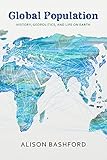Global Population : History, Geopolitics, and Life on Earth / Alison Bashford.
Material type: TextSeries: Columbia Studies in International and Global HistoryPublisher: New York, NY : Columbia University Press, [2014]Copyright date: ©2014Description: 1 online resource (480 p.) : 15 b&w illustrationsContent type:
TextSeries: Columbia Studies in International and Global HistoryPublisher: New York, NY : Columbia University Press, [2014]Copyright date: ©2014Description: 1 online resource (480 p.) : 15 b&w illustrationsContent type: - 9780231147668
- 9780231519526
- HB849.44 .B37 2014
- online - DeGruyter
- Issued also in print.
| Item type | Current library | Call number | URL | Status | Notes | Barcode | |
|---|---|---|---|---|---|---|---|
 eBook
eBook
|
Biblioteca "Angelicum" Pont. Univ. S.Tommaso d'Aquino Nuvola online | online - DeGruyter (Browse shelf(Opens below)) | Online access | Not for loan (Accesso limitato) | Accesso per gli utenti autorizzati / Access for authorized users | (dgr)9780231519526 |
Browsing Biblioteca "Angelicum" Pont. Univ. S.Tommaso d'Aquino shelves, Shelving location: Nuvola online Close shelf browser (Hides shelf browser)

|

|

|

|

|

|

|
||
| online - DeGruyter Pasta : The Story of a Universal Food / | online - DeGruyter The Islamic Context of The Thousand and One Nights / | online - DeGruyter On Civic Friendship : Including Women in the State / | online - DeGruyter Global Population : History, Geopolitics, and Life on Earth / | online - DeGruyter Love and Liberation : Autobiographical Writings of the Tibetan Buddhist Visionary Sera Khandro / | online - DeGruyter Queer Beauty : Sexuality and Aesthetics from Winckelmann to Freud and Beyond / | online - DeGruyter Workers, Unions, and Global Capitalism : Lessons from India / |
Frontmatter -- Contents -- Acknowledgments -- Introduction -- Part I. The long nineteenth Century -- 1. Confined in Room -- Part II. The Politics of Earth, 1920s and 1930s -- 2. War and Peace -- 3. Density -- 4. Migration -- 5. Waste lands -- Part III. The Politics of life, 1920s and 1930s -- 6. Life on Earth -- 7. Soil and Food -- 8. Sex -- 9. The Species -- Part IV. Between One World and Three Worlds, 1940s to 1968 -- 10. Food and Freedom -- 11. Life and Death -- 12. Universal Rights? -- Conclusion -- Notes -- Archival Collections -- Index
restricted access online access with authorization star
http://purl.org/coar/access_right/c_16ec
Concern about the size of the world's population did not begin with the "population bomb" in 1968. It arose in the aftermath of World War I and was understood as an issue with far-reaching ecological, agricultural, economic, and geopolitical consequences. The world population problem concerned the fertility of soil as much as the fertility of women, always involving both "earth" and "life."Global Population traces the idea of a world population problem as it evolved from the 1920s through the 1960s. The growth and distribution of the human population over the planet's surface came deeply to shape the characterization of "civilizations" with different standards of living. It forged the very ideas of development, demographically defined three worlds, and, for some, an aspirational "one world."Drawing on international conference transcripts and personal and organizational archives, this book reconstructs the twentieth-century population problem in terms of migration, colonial expansion, globalization, and world food plans. Population was a problem in which international relations and intimate relations were one. Global Population ultimately shows how a geopolitical problem about sovereignty over land morphed into a biopolitical solution, entailing sovereignty over one's person.
Issued also in print.
Mode of access: Internet via World Wide Web.
In English.
Description based on online resource; title from PDF title page (publisher's Web site, viewed 02. Mrz 2022)


